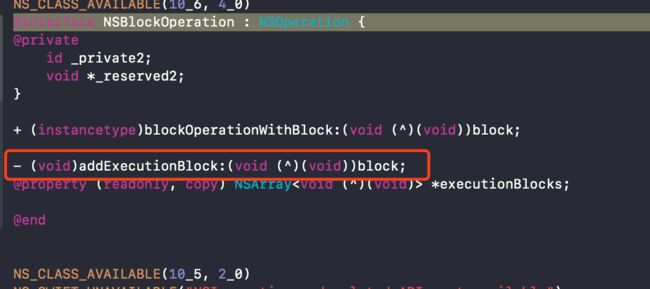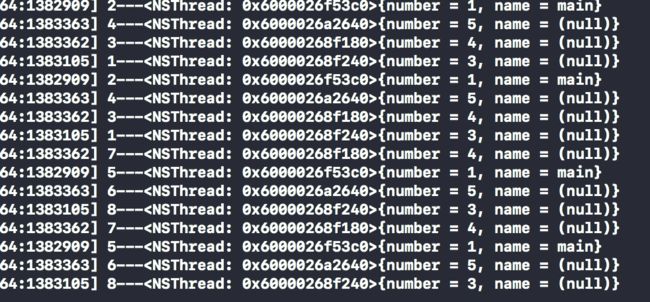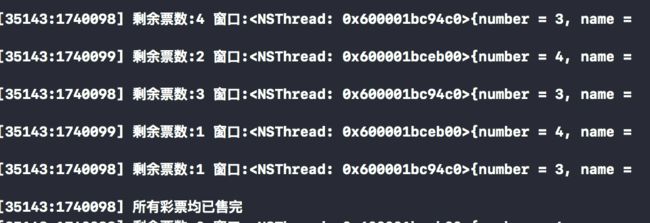紧接着上一篇GCD 之后 今天给大家 分享和总结的是NSOperation
废话不多说:来看看NSOperation 是什么鬼?
官网的解释是:
翻译:一个抽象类,表示与单个任务关联的代码和数据
如果你有阅读过 SDWebImage和AFNetworking的源码的话 那么你就会注意到里面大量的用到了大量的 NSOperation 为什么呢?
原因:
NSOperation、NSOperationQueue 是基于 GCD 更高一层的封装,完全面向对象。但是比 GCD 更简单易用、代码可读性也更高。
- 可添加完成的代码块,在操作完成后执行。
- 添加操作之间的依赖关系,方便的控制执行顺序。
- 设定操作执行的优先级。
- 可以很方便的取消一个操作的执行。
- 使用 KVO 观察对操作执行状态的更改:
isExecuteing、isFinished、isCancelled。
NSOperation的使用
NS_CLASS_AVAILABLE(10_6, 4_0)
@interface NSBlockOperation : NSOperation {
@private
id _private2;
void *_reserved2;
}
+ (instancetype)blockOperationWithBlock:(void (^)(void))block;
- (void)addExecutionBlock:(void (^)(void))block;
@property (readonly, copy) NSArray *executionBlocks;
@end
NS_CLASS_AVAILABLE(10_5, 2_0)
NS_SWIFT_UNAVAILABLE("NSInvocation and related APIs not available")
@interface NSInvocationOperation : NSOperation {
@private
id _inv;
id _exception;
void *_reserved2;
}
- (nullable instancetype)initWithTarget:(id)target selector:(SEL)sel object:(nullable id)arg;
- (instancetype)initWithInvocation:(NSInvocation *)inv NS_DESIGNATED_INITIALIZER;
@property (readonly, retain) NSInvocation *invocation;
@property (nullable, readonly, retain) id result;
@end
NSOperation不可以直接创建,但是可以使用它的子类NSBlockOperation和NSInvocationOperation,前者是使用Block的方式,使用起来比较方便。
NSBlockOperation
/**
* 使用子类 NSBlockOperation
*/
- (void)useBlockOperation {
// 1.创建 NSBlockOperation 对象
NSBlockOperation *op = [NSBlockOperation blockOperationWithBlock:^{
for (int i = 0; i < 2; i++) {
[NSThread sleepForTimeInterval:2]; // 模拟耗时操作
NSLog(@"1---%@", [NSThread currentThread]); // 打印当前线程
}
}];
// 2.调用 start 方法开始执行操作
[op start];
}
可以看出NSBlockOperation 默认在主线程中执行
看下addExecutionBlock
/**
* 使用子类 NSBlockOperation
* 调用方法 AddExecutionBlock:
*/
- (void)useBlockOperationAddExecutionBlock {
// 1.创建 NSBlockOperation 对象
NSBlockOperation *op = [NSBlockOperation blockOperationWithBlock:^{
for (int i = 0; i < 2; i++) {
[NSThread sleepForTimeInterval:2]; // 模拟耗时操作
NSLog(@"1---%@", [NSThread currentThread]); // 打印当前线程
}
}];
// 2.添加额外的操作
[op addExecutionBlock:^{
for (int i = 0; i < 2; i++) {
[NSThread sleepForTimeInterval:2]; // 模拟耗时操作
NSLog(@"2---%@", [NSThread currentThread]); // 打印当前线程
}
}];
[op addExecutionBlock:^{
for (int i = 0; i < 2; i++) {
[NSThread sleepForTimeInterval:2]; // 模拟耗时操作
NSLog(@"3---%@", [NSThread currentThread]); // 打印当前线程
}
}];
[op addExecutionBlock:^{
for (int i = 0; i < 2; i++) {
[NSThread sleepForTimeInterval:2]; // 模拟耗时操作
NSLog(@"4---%@", [NSThread currentThread]); // 打印当前线程
}
}];
[op addExecutionBlock:^{
for (int i = 0; i < 2; i++) {
[NSThread sleepForTimeInterval:2]; // 模拟耗时操作
NSLog(@"5---%@", [NSThread currentThread]); // 打印当前线程
}
}];
[op addExecutionBlock:^{
for (int i = 0; i < 2; i++) {
[NSThread sleepForTimeInterval:2]; // 模拟耗时操作
NSLog(@"6---%@", [NSThread currentThread]); // 打印当前线程
}
}];
[op addExecutionBlock:^{
for (int i = 0; i < 2; i++) {
[NSThread sleepForTimeInterval:2]; // 模拟耗时操作
NSLog(@"7---%@", [NSThread currentThread]); // 打印当前线程
}
}];
[op addExecutionBlock:^{
for (int i = 0; i < 2; i++) {
[NSThread sleepForTimeInterval:2]; // 模拟耗时操作
NSLog(@"8---%@", [NSThread currentThread]); // 打印当前线程
}
}];
// 3.调用 start 方法开始执行操作
[op start];
}
// 1.创建 NSBlockOperation 对象
NSBlockOperation *op = [NSBlockOperation blockOperationWithBlock:^{
for (int i = 0; i < 2; i++) {
[NSThread sleepForTimeInterval:2]; // 模拟耗时操作
NSLog(@"1---%@", [NSThread currentThread]); // 打印当前线程
}
}];
可以看出上面是在主线程中执行
使用自定义继承自 NSOperation 的子类
@implementation JFOperation
/**
重写mian方法
*/
- (void)main {
if (!self.isCancelled) {
for (int i = 0; i < 2; i++) {
[NSThread sleepForTimeInterval:2];
NSLog(@"1---%@", [NSThread currentThread]);
}
}
}
@end
/**
* 使用自定义继承自 NSOperation 的子类
*/
- (void)useCustomOperation {
// 1.创建 JFOperation 对象
JFOperation *op = [[JFOperation alloc] init];
// 2.调用 start 方法开始执行操作
[op start];
}
NSOperationQueue的使用
NS_CLASS_AVAILABLE(10_5, 2_0)
@interface NSOperationQueue : NSObject {
@private
id _private;
void *_reserved;
}
- (void)addOperation:(NSOperation *)op;
- (void)addOperations:(NSArray *)ops waitUntilFinished:(BOOL)wait API_AVAILABLE(macos(10.6), ios(4.0), watchos(2.0), tvos(9.0));
- (void)addOperationWithBlock:(void (^)(void))block API_AVAILABLE(macos(10.6), ios(4.0), watchos(2.0), tvos(9.0));
@property (readonly, copy) NSArray<__kindof NSOperation *> *operations;
@property (readonly) NSUInteger operationCount API_AVAILABLE(macos(10.6), ios(4.0), watchos(2.0), tvos(9.0));
@property NSInteger maxConcurrentOperationCount;
@property (getter=isSuspended) BOOL suspended;
@property (nullable, copy) NSString *name API_AVAILABLE(macos(10.6), ios(4.0), watchos(2.0), tvos(9.0));
@property NSQualityOfService qualityOfService API_AVAILABLE(macos(10.10), ios(8.0), watchos(2.0), tvos(9.0));
@property (nullable, assign /* actually retain */) dispatch_queue_t underlyingQueue API_AVAILABLE(macos(10.10), ios(8.0), watchos(2.0), tvos(9.0));
- (void)cancelAllOperations;
- (void)waitUntilAllOperationsAreFinished;
@property (class, readonly, strong, nullable) NSOperationQueue *currentQueue API_AVAILABLE(macos(10.6), ios(4.0), watchos(2.0), tvos(9.0));
@property (class, readonly, strong) NSOperationQueue *mainQueue API_AVAILABLE(macos(10.6), ios(4.0), watchos(2.0), tvos(9.0));
@end
NS_ASSUME_NONNULL_END
如上系统api所示:NSOperationQueue有一个
@property NSInteger maxConcurrentOperationCount;属性
顾名思义 最大的并发操作数
最大并发操作数:maxConcurrentOperationCount
maxConcurrentOperationCount默认情况下为-1,表示不进行限制,可进行并发执行。
maxConcurrentOperationCount为1时,队列为串行队列。只能串行执行。
maxConcurrentOperationCount大于1时,队列为并发队列。操作并发执行,当然这个值不应超过系统限制,即使自己设置一个很大的值,系统也会自动调整为 min{自己设定的值,系统设定的默认最大值}。
maxConcurrentOperationCount = 1
如上图
maxConcurrentOperationCount= 1 是串行
maxConcurrentOperationCount = 2
如上图
maxConcurrentOperationCount= 2 是并发
maxConcurrentOperationCount = 9
maxConcurrentOperationCount 也是并发
开启线程数量是由系统决定的,不需要我们来管理
NSOperation 操作依赖
- (void)addDependency:(NSOperation *)op;
- (void)removeDependency:(NSOperation *)op;
@property (readonly, copy) NSArray *dependencies;
/**
* 操作依赖
* 使用方法:addDependency:
*/
- (void)addDependency {
// 1.创建队列
NSOperationQueue *queue = [[NSOperationQueue alloc] init];
// 2.创建操作
NSBlockOperation *op1 = [NSBlockOperation blockOperationWithBlock:^{
for (int i = 0; i < 2; i++) {
[NSThread sleepForTimeInterval:2]; // 模拟耗时操作
NSLog(@"1---%@", [NSThread currentThread]); // 打印当前线程
}
}];
NSBlockOperation *op2 = [NSBlockOperation blockOperationWithBlock:^{
for (int i = 0; i < 2; i++) {
[NSThread sleepForTimeInterval:2]; // 模拟耗时操作
NSLog(@"2---%@", [NSThread currentThread]); // 打印当前线程
}
}];
// 3.添加依赖
[op2 addDependency:op1]; // 让op2 依赖于 op1,则先执行op1,在执行op2
// 4.添加操作到队列中
[queue addOperation:op1];
[queue addOperation:op2];
}
如打印:op2在op1后执行
NSOperation、NSOperationQueue 线程间的通信
/**
* 线程间通信
*/
- (void)communication {
// 1.创建队列
NSOperationQueue *queue = [[NSOperationQueue alloc]init];
// 2.添加操作
[queue addOperationWithBlock:^{
// 异步进行耗时操作
for (int i = 0; i < 2; i++) {
[NSThread sleepForTimeInterval:2]; // 模拟耗时操作
NSLog(@"1---%@", [NSThread currentThread]); // 打印当前线程
}
// 回到主线程
[[NSOperationQueue mainQueue] addOperationWithBlock:^{
// 进行一些 UI 刷新等操作
for (int i = 0; i < 2; i++) {
[NSThread sleepForTimeInterval:2]; // 模拟耗时操作
NSLog(@"2---%@", [NSThread currentThread]); // 打印当前线程
}
}];
}];
}
打印如上这个和NSThred和GCD一样。也是先在其他线程中执行操作,等操作执行完了之后再回到主线程执行主线程的相应操作
打印如上票数是错乱的
/**
* 线程安全:使用 NSLock
* 初始化彩票数量、卖票窗口(线程安全)、并开始卖票
*/
- (void)initTicketStatusSave {
NSLog(@"currentThread---%@",[NSThread currentThread]); // 打印当前线程
self.ticketSurplusCount = 50;
self.lock = [[NSLock alloc] init]; // 初始化 NSLock 对象
// 1.创建 queue1,queue1 代表足球彩票售卖窗口
NSOperationQueue *queue1 = [[NSOperationQueue alloc] init];
queue1.maxConcurrentOperationCount = 1;
// 2.创建 queue2,queue2 代表篮球票售卖窗口
NSOperationQueue *queue2 = [[NSOperationQueue alloc] init];
queue2.maxConcurrentOperationCount = 1;
// 3.创建卖票操作 op1
__weak typeof(self) weakSelf = self;
NSBlockOperation *op1 = [NSBlockOperation blockOperationWithBlock:^{
[weakSelf saleTicketSafe];
}];
// 4.创建卖票操作 op2
NSBlockOperation *op2 = [NSBlockOperation blockOperationWithBlock:^{
[weakSelf saleTicketSafe];
}];
// 5.添加操作,开始卖票
[queue1 addOperation:op1];
[queue2 addOperation:op2];
}
/**
* 售卖彩票票(线程安全)
*/
- (void)saleTicketSafe {
while (1) {
// 加锁
[self.lock lock];
if (self.ticketSurplusCount > 0) {
//如果还有票,继续售卖
self.ticketSurplusCount--;
NSLog(@"%@", [NSString stringWithFormat:@"剩余票数:%ld 窗口:%@", (long)self.ticketSurplusCount, [NSThread currentThread]]);
[NSThread sleepForTimeInterval:0.2];
}
// 解锁
[self.lock unlock];
if (self.ticketSurplusCount <= 0) {
NSLog(@"所有彩票均已售完");
break;
}
}
}
打印如上 正是我们想要的结果
NSOperation,NSOperationQueue 的优先级
NSOperation对象使用setQueuePriority:设置自身在NSOperationQueue对象中执行的优先级。参数有:
typedef NS_ENUM(NSInteger, NSOperationQueuePriority) {
NSOperationQueuePriorityVeryLow = -8L,
NSOperationQueuePriorityLow = -4L,
NSOperationQueuePriorityNormal = 0,
NSOperationQueuePriorityHigh = 4,
NSOperationQueuePriorityVeryHigh = 8
};
-(void)queuePriority{
NSBlockOperation *blkop1 = [NSBlockOperation blockOperationWithBlock:^{
NSLog(@"执行blkop1");
}];
NSBlockOperation *blkop2 = [NSBlockOperation blockOperationWithBlock:^{
NSLog(@"执行blkop2");
}];
// 设置操作优先级
blkop1.queuePriority = NSOperationQueuePriorityLow;
blkop2.queuePriority = NSOperationQueuePriorityVeryHigh;
NSLog(@"blkop1 == %@",blkop1);
NSLog(@"blkop2 == %@",blkop2);
NSOperationQueue *queue = [[NSOperationQueue alloc] init];
// 操作添加到队列
[queue addOperation:blkop1];
[queue addOperation:blkop2];
NSLog(@"%@",[queue operations]);
for (NSOperation *op in [queue operations]) {
NSLog(@"op == %@",op);
}
}
注意:
- 优先级只能应用于相同queue中的operations。
- 操作的优先级高低不等于操作在队列中排列的顺序。换句话说,优先级高的操作不代表一定排在队列的前面。后入队的操作有可能因为优先级高而先被执行。PS:操作在队列中的顺序取决于队列的addOperation:方法。
- 优先级高只代表先被执行。不代表操作先被执行完成。执行完成的早晚还取决于操作耗时长短。
- 优先级不能替代依赖,优先级也绝不等于依赖。优先级只是对已经准备好的操作确定其执行顺序。
- 操作的执行优先满足依赖关系,然后再满足优先级。即先根据依赖执行操作,然后再从所有准备好的操作中取出优先级最高的那一个执行。
好了 NSOperation 的分享就到这里 下篇将会给大家带来NSRunloop大家哪里不清楚的 ,有啥想了解的 在评论区评论。
demo地址:https://github.com/tubie/JFMultiThreading












